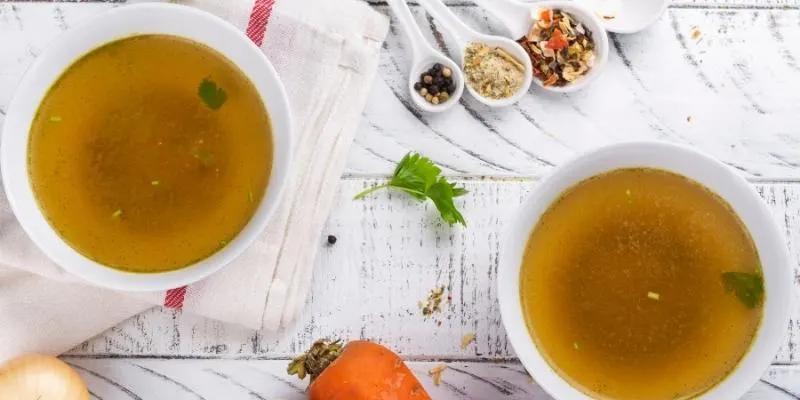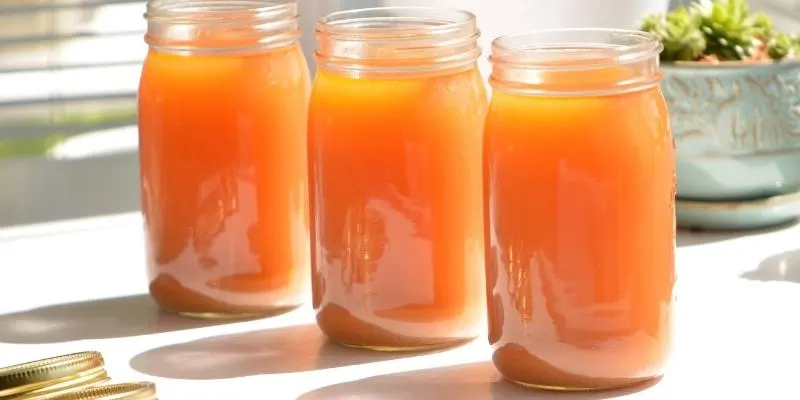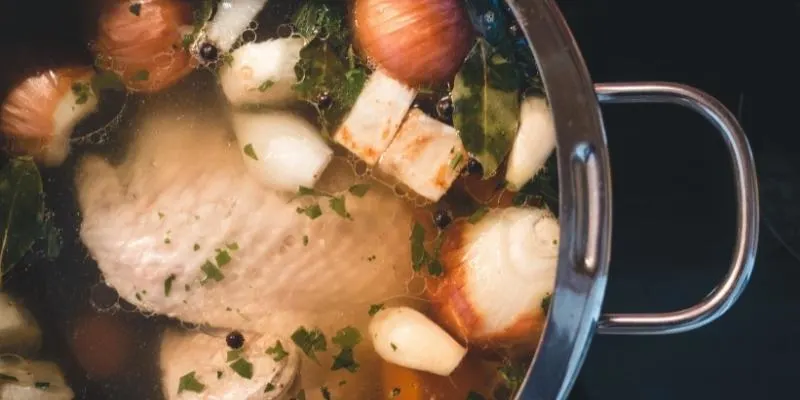Trying to figure out if your stock should be clear or not ? You’re not alone, plenty of people ask themselves the same thing each time they make a pot of delicious, nutritious stock that just happens to be cloudy. Is it okay if stock is cloudy ? Should it be clear ? How do you clarify a stock in the first place ? And what about stock made from roast, like the Thanksgiving stock ? That’s always cloudy, how can you get a clear stock out of that ? Well, let’s take a look at why stock gets cloudy in the first place, and then if it should be clear or not.

Why is stock cloudy ?
Stock can be cloudy due to the ingredients emulsifying into the liquid, due to boiling instead of simmering, and due to not straining the stock. Getting clear stock isn’t easy and it’s definitely something you learn to make along the way, but it is in no way crucial or necessary. It’s a very personal decision. Here are the two main reasons for why stock is cloudy, explained in more detail.
Stock was boiled, not simmered
When you’re making stock, you need very low heat, just below the boiling point. This is hard to control on a gas stove, but it’s possible and we’ve explained it in more detail further in the article. Still, boiling will break down the ingredients faster than it gets the flavor out, and tiny, tiny pieces will break off the ingredients and mingle with the liquid. To avoid or mitigate this, do your best to keep the flame on the lowest setting of the smallest burner.
Stock was not strained, or improperly strained
Often, no matter how hard you try, the stock will be a little cloudy. And that’s fine, it does not impact flavor or quality at all. It’s just a visual thing. But if you’re looking to get the clearest stock, you’re going to need to strain it, several times, through several meshes and cheesecloths.
Improperly straining (like with meshes that aren’t fine enough) or straining just once may not give you a clear enough stock. The aim of the mesh or cheesecloth is to get as much tiny ingredient fragments, fat, and protein foam out of the liquid. Even so, you might not get a 100% clear stock but it will be much clearer.
Read also: Why Is Risotto Hard To Make?
Does stock have to be clear ?
This is a heavily personal decision. Cloudiness does not affect flavor all that much, but it can have a visual impact. High level chefs may want their stock to be clear in most cases, and they also know there are cases when the clarity doesn’t matter. So in the end it depends on your personal preference and what you’re cooking.
Are you making any sort of stew or braise ? The stock doesn’t need to be clear, there will be plenty of ingredients broken down in the liquid anyway.
Are you making soup ? This is personal. Some, like me for example, dislike clear soup and don’t like seeing all the way into the bottom of the bowl. Others prefer to know that their soup looks clean and clear, and would like their stock clear.

Typical color and clarity for roast turkey stock (not clarified).
What about Thanksgiving turkey stock ?
This is a difficult stock to clear because, well, it will be a heavily colored stock due to the bird being roasted. There is plenty of oil and fat already rendered from when the bird was first cooked. But you can still get a mostly clear stock, but it won’t be see-through as if you were using fresh, raw turkey.
The flavor will be great, the color will be great, but you will need to strain it 2-3 times and lower your expectations on clarity.
Read also: Can You Overcook Soup ? Does It Get Better In Time ?
How to make sure your stock is as clear as possible
Want to make sure you get the clearest stock possible ? That won’t be easy, but it’s entirely possible, as long as you’re willing to take some extra steps, and be mindful of exactly what you’re using in your pot.
Start with cold ingredients in cold water
Ideally when you begin you stock, you should have all ingredients ready and prepped (cleaned, cut). Starting from a low temperature with cold water ensures the stock does not get too hot, and the ingredients don’t emulsify as they break down. This point is heavily tied to the next one, and is the basis for it actually.
Use bones, skin, and connective tissue
The best stock always comes out of simmering bones, skin, and connective tissue, for better flavor and collagen. This will give the stock a slightly thick, silky feel and it’s also the way to get jelly at the end (if you let it cool). Of course, to get it to gel it has to be pretty concentrated and left in a very cold place (like the fridge).

Understand the difference between a simmer and a gentle boil
When you’re making a stock, you need to get your liquid simmering, not boiling. This is very difficult to do, especially if you’re on a gas stove. The difference between a simmer and a gentle boil is that a simmer won’t produce bubbles that rise to the surface. This means that the simmer is at a below-boiling temperature, around 190F (water starts to boil at 212F). But, you need to get the stock boiling to then let it simmer.
On an electric or induction stove this is easier to manage. On a gas stove your best bet is to use a wide pot, have one end on the burner on the lowest setting, and the other one not on the burner. The difference in heat in the liquid will get you as close to a simmer as humanly and gas-stove possible.
Use long, slow, gentle cooking
Stock making is a long process, and the longer you cook those ingredients that better the flavor. But we don’t want high heat, not even medium heat. This is why it takes a long time to get all those flavors, and why stocks can take at least 3 hours to make. These things are delicious but slow.
Read also: Vegetarian Substitute For Chicken Broth
Use an egg white raft to clarify as you cook
This sounds weirder than it is, but bear with me. This is lifted directly from a consomme recipe, which is essentially very clarified stock. The egg whites are protein, and anything that might be floating in the stock will stick into the egg whites as the stock is simmering. So little bits of meat, the protein foam, a bit of marrow, stuff like that. To do this, prep your stock ingredients as usual, put them in the pot, then turn on the heat.
Whip a couple of egg whites, but enough to get a meringue going. No yolks, they won’t help, we need just the protein ‘mesh’ the whites give. Pour the whipped egg whites into the pot, they should cover up most of the top of the water. As the stock simmers, the egg whites form a sort of lid and will trap most of the impurities that could turn your stock cloudy. Poke a small hole in the middle of the raft, so stem can escape if the edges are stuck to the pot.
When the stock is done simmering, remove the egg whites. The stock should be significantly clearer than without the raft. You might still need to strain the stock though.

